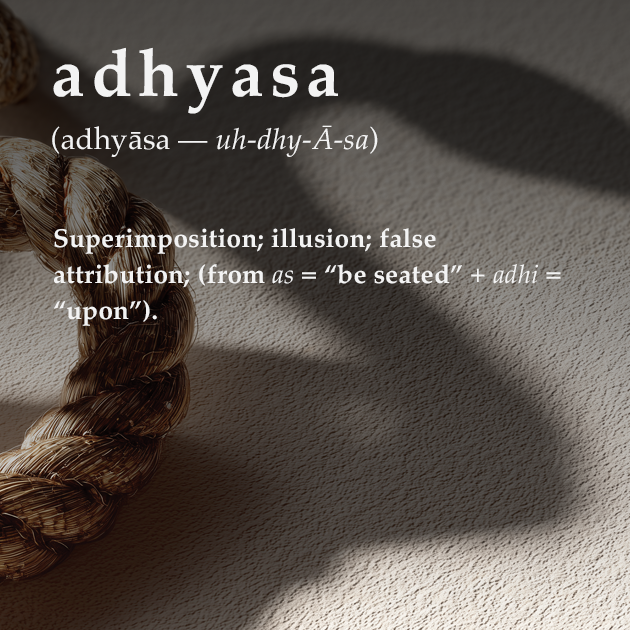Adhyasa – The Mistaking of the Self
- Daniel McKenzie

- Jul 28
- 4 min read
Updated: Dec 11

In a dim alley at dusk, something coiled lies across your path. Your breath tightens. The heart leaps. You see a snake. But it’s only a rope.
This is adhyasa (adhyāsa)—the error of superimposition. A false overlay of one thing onto another, born of incomplete knowledge. You saw the rope, but not clearly. So the mind filled in the rest, projecting fear where there was none. The illusion vanished when the truth was known, but not before the body had tensed, the breath had faltered, and suffering had begun.
Vedanta tells us that this is not a rare occurrence. It is our constant state. We live not in truth, but in projection. We mistake the body for the Self, the mind for identity, the world for permanence. We fear death as if we could die, grieve loss as if anything were ever ours. The Self—unchanging, unborn, untouched—is superimposed with the attributes of the body. In return, the body and mind are assumed to be conscious and real in themselves.
This mutual misidentification—between the Knower and the known (in the Bhagavad Gita, the kshetrajna and the kshetra) is adhyasa. It is not metaphor. It is the root of every thought and action in a life lived without Self-knowledge.
There are two classical forms of adhyasa:
1. The individual projection (pratibhasika):
You see a snake where there is a rope. The mind, operating under partial ignorance, fills in the missing details. When corrected by knowledge, the illusion ends. This is error by personal misapprehension, and it can be resolved by direct perception.
2. The cosmic projection (vyavaharika):
You see the sun rise and set. The trees appear to move as the train rolls forward. These illusions persist not because you’re personally mistaken, but because of the reference frame you’re embedded in. The body-mind itself is a reference frame. Even when you know the truth, the world appears as before. The illusion doesn’t end—but you no longer believe it.
This second kind of adhyasa is not your doing. It is Ishvara srishti—the projection of maya. You cannot stop the sunrise by knowing the sun does not rise. But you stop suffering over it.
When Arjuna lays down his bow at the start of the Gita, he is overwhelmed by grief. But the grief is not love. It is moha—delusion. He has confused adharma for dharma. He imagines virtue in abandoning his duty. He mistakes emotion for truth. This is adhyasa in action.
Arjuna is not seeing reality as it is. He is seeing through the lens of attachment—raga—which gives rise to sorrow—shoka—which clouds his judgment—moha. From there, all action is misaligned. Dharma bends under the weight of his projection.
Krishna doesn’t fix Arjuna’s grief by offering comfort. He corrects the error. He shines light on the rope.
Adhyasa is not just a concept to grasp—it is the very mechanism of suffering. To superimpose is to suffer. To misidentify is to be bound. Freedom (moksha) is not a change in the world—it is the removal of error.
When you know the rope, the snake disappears. But when you know the Self, the world remains—but you are free of it.
Even the enlightened, the jnani, continues to see sunrise and sunset. But he knows what is real. He walks through the world like one in a lucid dream—not disturbed, not confused. The projection remains, but the identification is gone.
Adhyasa is where Vedanta begins. Shankara opens his commentary on the Brahma Sutras with this very error. Without understanding adhyasa, the rest of Vedanta cannot be understood. For it is not a philosophy of belief, but a path of correction—a lifting of the veil, a waking from a misperception that never was.
To see clearly is not to change what is seen. It is to know what you are—not the seen, not the body, not the mind. But That which sees.
Root & Meaning
Sanskrit adhi- (“upon”) + āsa (“to sit”); literally “to sit upon” or “superimpose.”
Scriptural References
Bhagavad Gita (2.16, 2.22, 13.1–2) – Contrasts the perishable field (kshetra) with the imperishable Knower (kshetrajna).
Brahma Sutra Bhashya (Introductory Adhyasa Bhashya by Shankara) – Defines adhyasa as the superimposition of the Self and the not-Self.
Mundaka Upanishad (2.2.5) – The rope-snake metaphor as an example of ignorance-based error.
Mandukya Karika (3.29–31) – Describes waking life as projection due to ignorance.
Vivekachudamani (108–111) – Lists adhyasa as the fundamental cause of bondage.
Traditional View
The mechanism by which avidya operates, causing the confusion of Self and non-Self.
Vedantic Analysis
Adhyasa has no independent reality; it is sublated through Self-knowledge, just like the snake disappears when the rope is recognized.
Common Misunderstandings
Believing adhyasa is a conscious act rather than an automatic, unconscious projection.
Assuming it can be removed by willpower alone without Self-knowledge.
Vedantic Resolution
Discrimination (viveka) and sustained contemplation (nididhyasana) reveal the Self and dissolve adhyasa.
